中间过程、临界现象--分数阶算子理论、方法、进展
- 格式:pdf
- 大小:490.57 KB
- 文档页数:17
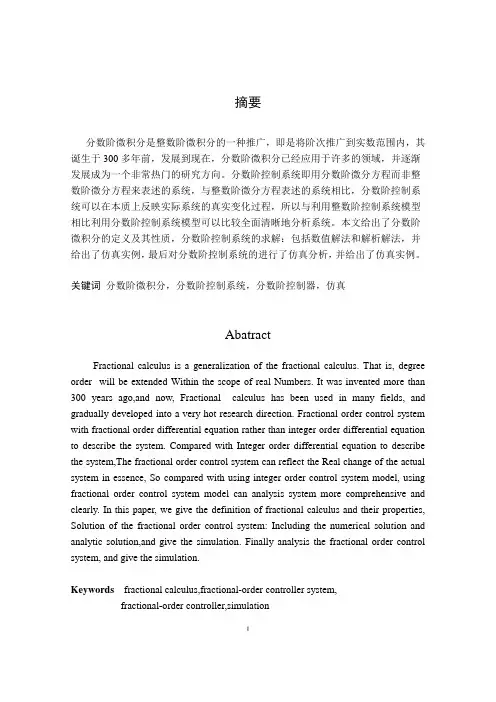
摘要分数阶微积分是整数阶微积分的一种推广,即是将阶次推广到实数范围内,其诞生于300多年前,发展到现在,分数阶微积分已经应用于许多的领域,并逐渐发展成为一个非常热门的研究方向。
分数阶控制系统即用分数阶微分方程而非整数阶微分方程来表述的系统,与整数阶微分方程表述的系统相比,分数阶控制系统可以在本质上反映实际系统的真实变化过程,所以与利用整数阶控制系统模型相比利用分数阶控制系统模型可以比较全面清晰地分析系统。
本文给出了分数阶微积分的定义及其性质,分数阶控制系统的求解:包括数值解法和解析解法,并给出了仿真实例,最后对分数阶控制系统的进行了仿真分析,并给出了仿真实例。
关键词分数阶微积分,分数阶控制系统,分数阶控制器,仿真AbatractFractional calculus is a generalization of the fractional calculus. That is, degree order will be extended Within the scope of real Numbers. It was invented more than 300 years ago,and now, Fractional calculus has been used in many fields, and gradually developed into a very hot research direction. Fractional order control system with fractional order differential equation rather than integer order differential equation to describe the system. Compared with Integer order differential equation to describe the system,The fractional order control system can reflect the Real change of the actual system in essence, So compared with using integer order control system model, using fractional order control system model can analysis system more comprehensive and clearly. In this paper, we give the definition of fractional calculus and their properties, Solution of the fractional order control system: Including the numerical solution and analytic solution,and give the simulation. Finally analysis the fractional order control system, and give the simulation.Keywords fractional calculus,fractional-order controller system,fractional-order controller,simulationI目录摘要 (I)Abatract (I)1绪论 (1)1.1 课题的背景和意义 (1)1.2分数阶微积分的应用发展 (2)1.3本文研究内容 (3)2数学理论基础....................................................................................................... .. (3)2.1数学基本函数 (4)2.2 分数阶微积分的定义 (8)2.3 分数阶微积分的性质 (11)2.4 拉普拉斯变换 (12)2.5分数阶微积分的仿真实例 (13)2.6本章小结 (17)3 分数阶控制系统的求解 (18)3.1 分数阶微分方程 (18)3.2分数阶微分方程的数值解法 (20)3.3分数阶微分方程的解析解法 (25)3.4 本章小结 (31)4分数阶控制系统的仿真 (32)4.1整数阶控制系统仿真实例 (32)4.2分数阶控制系统仿真实例 (36)4.3 本章小结 (44)5结论......................................................................................................................... . (45)致谢 (46)参考文献 (46)附录1外文资料翻译.................................................................................................. ..47 A1.1译文:分数阶控制系统的频域稳定性条件.. (47)A1.2原文:Frequency Domain Stability CriteriaforFractional-order Control Systems (57)附录2 附录程序........................................................................................................ ..681绪论1.1 课题的背景和意义分数阶微积分是一个历史悠久且依然新颖的概念,其诞生于300年前,分数阶微积分主要研究的是任意阶次的微分和积分的算子特性以及应用问题。
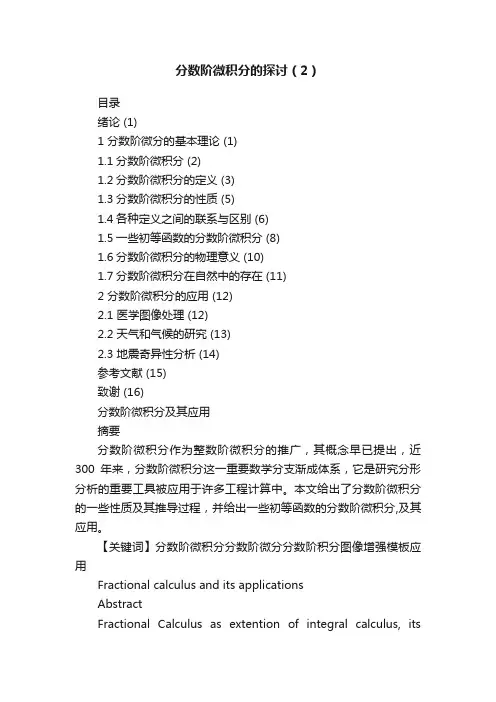
分数阶微积分的探讨(2)目录绪论 (1)1 分数阶微分的基本理论 (1)1.1分数阶微积分 (2)1.2分数阶微积分的定义 (3)1.3分数阶微积分的性质 (5)1.4各种定义之间的联系与区别 (6)1.5一些初等函数的分数阶微积分 (8)1.6分数阶微积分的物理意义 (10)1.7分数阶微积分在自然中的存在 (11)2 分数阶微积分的应用 (12)2.1 医学图像处理 (12)2.2 天气和气候的研究 (13)2.3 地震奇异性分析 (14)参考文献 (15)致谢 (16)分数阶微积分及其应用摘要分数阶微积分作为整数阶微积分的推广,其概念早已提出,近300年来,分数阶微积分这一重要数学分支渐成体系,它是研究分形分析的重要工具被应用于许多工程计算中。
本文给出了分数阶微积分的一些性质及其推导过程,并给出一些初等函数的分数阶微积分,及其应用。
【关键词】分数阶微积分分数阶微分分数阶积分图像增强模板应用Fractional calculus and its applicationsAbstractFractional Calculus as extention of integral calculus, itsconcept has long been proposed, for nearly 300 years, fractional calculus of this important branch of mathematics that had gradually become the system , it is the study of fractal analysis tools are used in many engineering calculations .in his paper, some properties of the fractional calculus and the derivation process of the fractional calculus are given, Besides some elementary functions of fractional calculus and its applications.【Key Words】Fractional Calculus Fractional derivatives Fractional integrals image enhancement applications绪论分数阶微积分是微积分的一个分支,它对函数进行分数阶微分积分,如对函数求1/2阶导数。
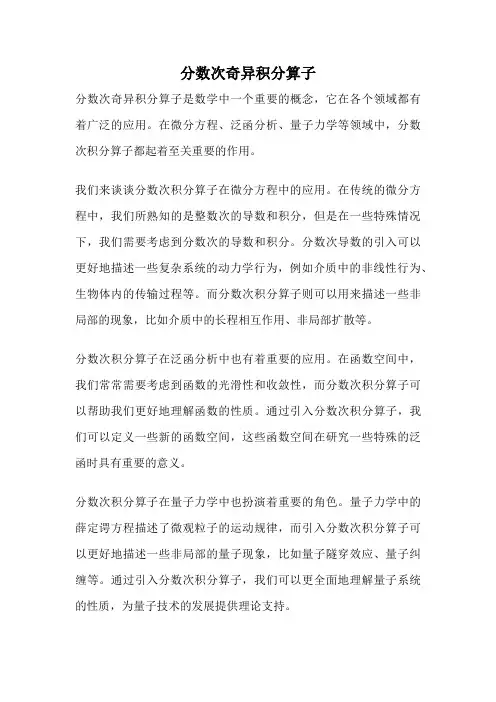
分数次奇异积分算子
分数次奇异积分算子是数学中一个重要的概念,它在各个领域都有着广泛的应用。
在微分方程、泛函分析、量子力学等领域中,分数次积分算子都起着至关重要的作用。
我们来谈谈分数次积分算子在微分方程中的应用。
在传统的微分方程中,我们所熟知的是整数次的导数和积分,但是在一些特殊情况下,我们需要考虑到分数次的导数和积分。
分数次导数的引入可以更好地描述一些复杂系统的动力学行为,例如介质中的非线性行为、生物体内的传输过程等。
而分数次积分算子则可以用来描述一些非局部的现象,比如介质中的长程相互作用、非局部扩散等。
分数次积分算子在泛函分析中也有着重要的应用。
在函数空间中,我们常常需要考虑到函数的光滑性和收敛性,而分数次积分算子可以帮助我们更好地理解函数的性质。
通过引入分数次积分算子,我们可以定义一些新的函数空间,这些函数空间在研究一些特殊的泛函时具有重要的意义。
分数次积分算子在量子力学中也扮演着重要的角色。
量子力学中的薛定谔方程描述了微观粒子的运动规律,而引入分数次积分算子可以更好地描述一些非局部的量子现象,比如量子隧穿效应、量子纠缠等。
通过引入分数次积分算子,我们可以更全面地理解量子系统的性质,为量子技术的发展提供理论支持。
总的来说,分数次积分算子是一个十分有趣且具有挑战性的数学概念,它在各个领域都有着广泛的应用前景。
通过对分数次积分算子的研究,我们可以更深入地理解复杂系统的动力学行为,推动数学和物理学的发展。
希望未来能有更多的学者投入到分数次积分算子的研究中,探索其中的奥秘,为人类的科学进步做出贡献。
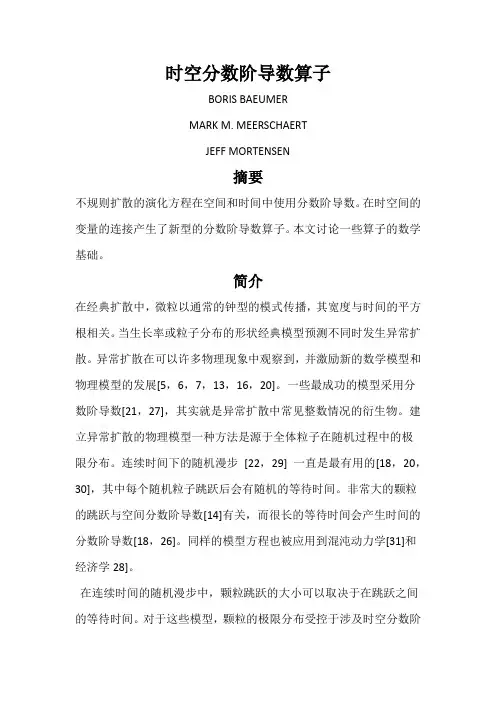
时空分数阶导数算子BORIS BAEUMERMARK M. MEERSCHAERTJEFF MORTENSEN摘要不规则扩散的演化方程在空间和时间中使用分数阶导数。
在时空间的变量的连接产生了新型的分数阶导数算子。
本文讨论一些算子的数学基础。
简介在经典扩散中,微粒以通常的钟型的模式传播,其宽度与时间的平方根相关。
当生长率或粒子分布的形状经典模型预测不同时发生异常扩散。
异常扩散在可以许多物理现象中观察到,并激励新的数学模型和物理模型的发展[5,6,7,13,16,20]。
一些最成功的模型采用分数阶导数[21,27],其实就是异常扩散中常见整数情况的衍生物。
建立异常扩散的物理模型一种方法是源于全体粒子在随机过程中的极限分布。
连续时间下的随机漫步[22,29] 一直是最有用的[18,20,30],其中每个随机粒子跳跃后会有随机的等待时间。
非常大的颗粒的跳跃与空间分数阶导数[14]有关,而很长的等待时间会产生时间的分数阶导数[18,26]。
同样的模型方程也被应用到混沌动力学[31]和经济学28]。
在连续时间的随机漫步中,颗粒跳跃的大小可以取决于在跳跃之间的等待时间。
对于这些模型,颗粒的极限分布受控于涉及时空分数阶导数算子的分数阶微分方程[3,19]。
本文建立了这些算子的数学基础。
尤其是,它们被证明是某些连续卷积半群的生成元,并且它们的域表现为一个合适的函数空间,其中的乘法的运算在傅立叶拉普拉斯空间的产物。
普通空时算子的一般形式被给出。
在这方面的发展中所使用的技术手段是算子半群[1,11,23],和算子稳定的概率分布的理论[12,15]。
分数阶导数和异常扩散让(,)C c t 表示粒子在位置x 处和时间t 时的相对浓度。
经典扩散方程212t x C C ∂=∂可以使用傅立叶变换(,)(,)ikx c k t e C x t dx =⎰求解,这把扩散方程转化为一个常微分方程的21/()2dc dt ik c =。
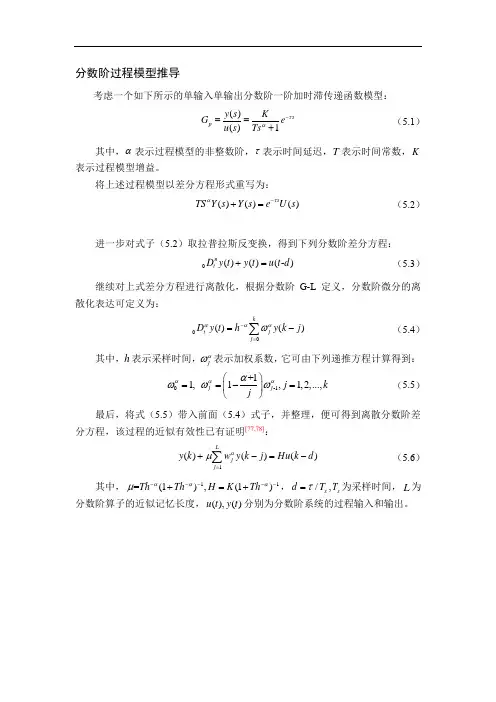
分数阶过程模型推导
考虑一个如下所示的单输入单输出分数阶一阶加时滞传递函数模型:
(5.1)
其中,α表示过程模型的非整数阶,τ表示时间延迟,T 表示时间常数,K 表示过程模型增益。
将上述过程模型以差分方程形式重写为:
(5.2)
进一步对式子(5.2)取拉普拉斯反变换,得到下列分数阶差分方程: (5.3)
继续对上式差分方程进行离散化,根据分数阶G -L 定义,分数阶微分的离散化表达可定义为:
00()()k t j
j D y t h y k j αααω-==-∑ (5.4)
其中,h 表示采样时间,j αω表示加权系数,
它可由下列递推方程计算得到: 0-1+11,1,1,2,...,j j j k j ααααωωω⎛⎫==-= ⎪⎝⎭ (5.5)
最后,将式(5.5)带入前面(5.4)式子,并整理,便可得到离散分数阶差分方程,该过程的近似有效性已有证明[77,78]:
1()()()L j j y k w y k j Hu k d α
μ=+-=-∑
(5.6)
其中,11=(1),(1)Th Th H K Th αααμ-----+=+,/s d T τ=,s T 为采样时间,L 为分数阶算子的近似记忆长度,(),()u t y t 分别为分数阶系统的过程输入和输出。
()()1s p y s K G e u s Ts τα-==+()()()s TS Y s Y s e U s ατ-+=0()()(-)n t D y t y t u t d +=。
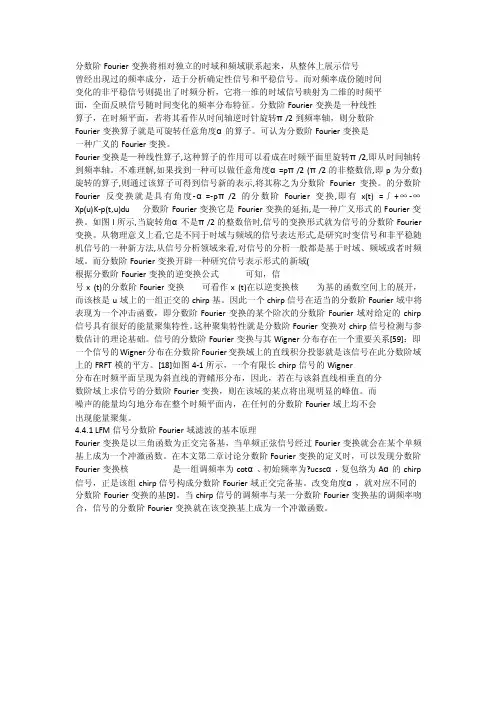
分数阶Fourier变换将相对独立的时域和频域联系起来,从整体上展示信号曾经出现过的频率成分,适于分析确定性信号和平稳信号。
而对频率成份随时间变化的非平稳信号则提出了时频分析,它将一维的时域信号映射为二维的时频平面,全面反映信号随时间变化的频率分布特征。
分数阶Fourier变换是一种线性算子,在时频平面,若将其看作从时间轴逆时针旋转π/2到频率轴,则分数阶Fourier变换算子就是可旋转任意角度α的算子。
可认为分数阶Fourier变换是一种广义的Fourier变换。
Fourier变换是—种线性算子,这种算子的作用可以看成在时频平面里旋转π/2,即从时间轴转到频率轴。
不难理解,如果找到一种可以做任意角度α=pπ/2 (π/2的非整数倍,即p为分数)旋转的算子,则通过该算子可得到信号新的表示,将其称之为分数阶Fourier变换。
的分数阶Fourier反变换就是具有角度-α=-pπ/2的分数阶Fourier变换,即有x(t) =∫+∞-∞Xp(u)K-p(t,u)du 分数阶Fourier变换它是Fourier变换的延拓,是—种广义形式的Fourier变换。
如图l所示,当旋转角α不是π/2的整数倍时,信号的变换形式就为信号的分数阶Fourier 变换。
从物理意义上看,它是不同于时域与频域的信号表达形式,是研究时变信号和非平稳随机信号的一种新方法,从信号分析领域来看,对信号的分析一般都是基于时域、频域或者时频域。
而分数阶Fourier变换开辟一种研究信号表示形式的新域(根据分数阶Fourier变换的逆变换公式可知,信号x (t)的分数阶Fourier变换可看作x (t)在以逆变换核为基的函数空间上的展开,而该核是u域上的一组正交的chirp基。
因此一个chirp信号在适当的分数阶Fourier域中将表现为一个冲击函数,即分数阶Fourier变换的某个阶次的分数阶Fourier域对给定的chirp 信号具有很好的能量聚集特性。
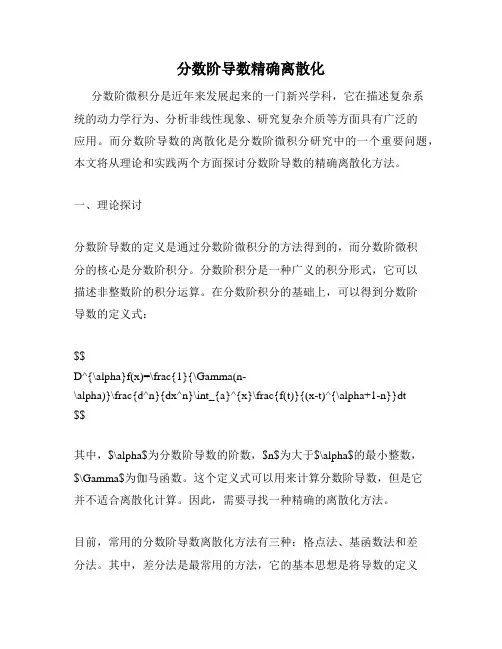
分数阶导数精确离散化分数阶微积分是近年来发展起来的一门新兴学科,它在描述复杂系统的动力学行为、分析非线性现象、研究复杂介质等方面具有广泛的应用。
而分数阶导数的离散化是分数阶微积分研究中的一个重要问题,本文将从理论和实践两个方面探讨分数阶导数的精确离散化方法。
一、理论探讨分数阶导数的定义是通过分数阶微积分的方法得到的,而分数阶微积分的核心是分数阶积分。
分数阶积分是一种广义的积分形式,它可以描述非整数阶的积分运算。
在分数阶积分的基础上,可以得到分数阶导数的定义式:$$D^{\alpha}f(x)=\frac{1}{\Gamma(n-\alpha)}\frac{d^n}{dx^n}\int_{a}^{x}\frac{f(t)}{(x-t)^{\alpha+1-n}}dt $$其中,$\alpha$为分数阶导数的阶数,$n$为大于$\alpha$的最小整数,$\Gamma$为伽马函数。
这个定义式可以用来计算分数阶导数,但是它并不适合离散化计算。
因此,需要寻找一种精确的离散化方法。
目前,常用的分数阶导数离散化方法有三种:格点法、基函数法和差分法。
其中,差分法是最常用的方法,它的基本思想是将导数的定义式中的积分离散化为差分形式,然后通过差分计算得到分数阶导数的近似值。
差分法的优点是简单易行,但是它的精度受到离散化误差的影响,因此需要进行一定的修正。
二、实践探讨为了验证分数阶导数离散化方法的精确性,我们进行了一系列的数值实验。
实验中,我们选取了一些常见的分数阶函数,如分数阶正弦函数、分数阶指数函数等,通过差分法和基函数法进行离散化计算,然后与理论值进行比较。
实验结果表明,差分法和基函数法都可以得到较为精确的分数阶导数值。
其中,差分法的精度受到离散化误差的影响,但是通过适当的修正可以得到较为准确的结果。
而基函数法的精度较高,但是计算量较大,需要进行一定的优化。
三、总结分数阶导数的精确离散化是分数阶微积分研究中的一个重要问题,它在实际应用中具有广泛的应用价值。
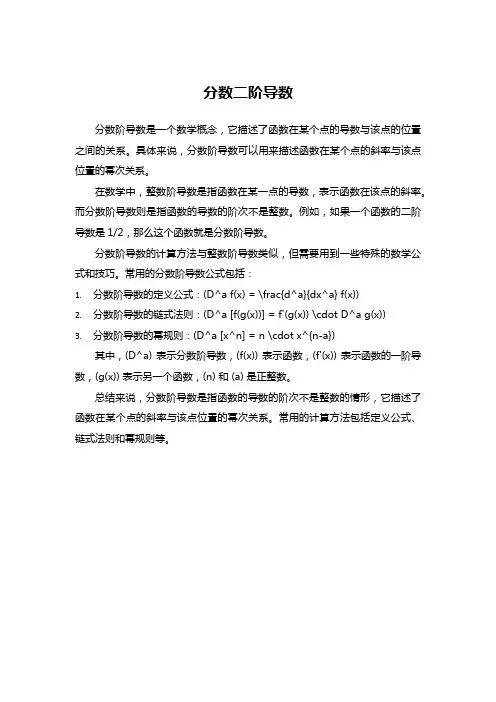
分数二阶导数
分数阶导数是一个数学概念,它描述了函数在某个点的导数与该点的位置之间的关系。
具体来说,分数阶导数可以用来描述函数在某个点的斜率与该点位置的幂次关系。
在数学中,整数阶导数是指函数在某一点的导数,表示函数在该点的斜率。
而分数阶导数则是指函数的导数的阶次不是整数。
例如,如果一个函数的二阶导数是1/2,那么这个函数就是分数阶导数。
分数阶导数的计算方法与整数阶导数类似,但需要用到一些特殊的数学公式和技巧。
常用的分数阶导数公式包括:
1.分数阶导数的定义公式:(D^a f(x) = \frac{d^a}{dx^a} f(x))
2.分数阶导数的链式法则:(D^a [f(g(x))] = f'(g(x)) \cdot D^a g(x))
3.分数阶导数的幂规则:(D^a [x^n] = n \cdot x^{n-a})
其中,(D^a) 表示分数阶导数,(f(x)) 表示函数,(f'(x)) 表示函数的一阶导数,(g(x)) 表示另一个函数,(n) 和 (a) 是正整数。
总结来说,分数阶导数是指函数的导数的阶次不是整数的情形,它描述了函数在某个点的斜率与该点位置的幂次关系。
常用的计算方法包括定义公式、链式法则和幂规则等。
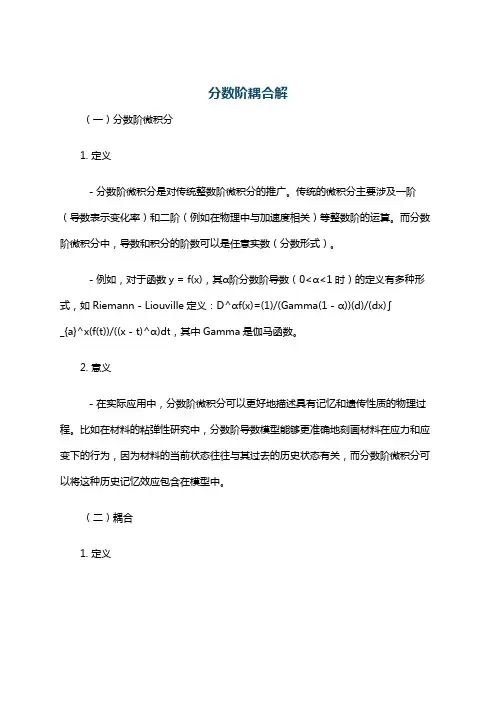
分数阶耦合解(一)分数阶微积分1. 定义- 分数阶微积分是对传统整数阶微积分的推广。
传统的微积分主要涉及一阶(导数表示变化率)和二阶(例如在物理中与加速度相关)等整数阶的运算。
而分数阶微积分中,导数和积分的阶数可以是任意实数(分数形式)。
- 例如,对于函数y = f(x),其α阶分数阶导数(0<α<1时)的定义有多种形式,如Riemann - Liouville定义:D^αf(x)=(1)/(Gamma(1 - α))(d)/(dx)∫_{a}^x(f(t))/((x - t)^α)dt,其中Gamma是伽马函数。
2. 意义- 在实际应用中,分数阶微积分可以更好地描述具有记忆和遗传性质的物理过程。
比如在材料的粘弹性研究中,分数阶导数模型能够更准确地刻画材料在应力和应变下的行为,因为材料的当前状态往往与其过去的历史状态有关,而分数阶微积分可以将这种历史记忆效应包含在模型中。
(二)耦合1. 定义- 在数学和物理学等领域,耦合是指两个或多个系统之间相互作用、相互影响的关系。
例如,在一个由多个振子组成的系统中,如果振子之间存在力的相互作用,使得一个振子的运动状态会影响到其他振子的运动状态,这种系统就是耦合系统。
- 从方程的角度看,对于两个变量x和y,如果它们满足方程组cases((dx)/(dt)=f(x,y)(dy)/(dt)=g(x,y)),这里x和y的变化率不仅取决于自身,还取决于对方,这就是一种耦合关系。
2. 类型- 线性耦合:如果耦合项在方程中是线性形式。
例如在方程组cases((dx)/(dt)=ax + by(dy)/(dt)=cx+dy)中,b和c表示线性耦合系数。
- 非线性耦合:当耦合项是非线性形式时。
如cases((dx)/(dt)=x^2+xy(dy)/(dt)=y^3-x^2y),这里的xy和x^2y等项体现了非线性耦合。
二、分数阶耦合方程的求解方法(一)解析方法1. 级数解法- 对于一些简单的分数阶耦合方程,可以尝试使用级数展开的方法求解。
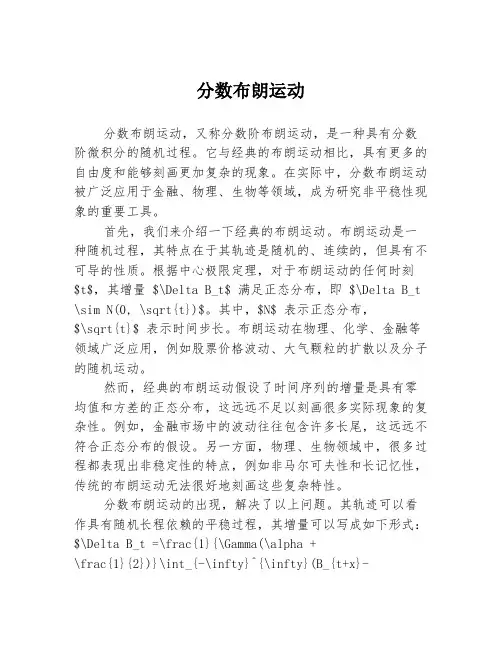
分数布朗运动分数布朗运动,又称分数阶布朗运动,是一种具有分数阶微积分的随机过程。
它与经典的布朗运动相比,具有更多的自由度和能够刻画更加复杂的现象。
在实际中,分数布朗运动被广泛应用于金融、物理、生物等领域,成为研究非平稳性现象的重要工具。
首先,我们来介绍一下经典的布朗运动。
布朗运动是一种随机过程,其特点在于其轨迹是随机的、连续的,但具有不可导的性质。
根据中心极限定理,对于布朗运动的任何时刻$t$,其增量 $\Delta B_t$ 满足正态分布,即 $\Delta B_t \sim N(0, \sqrt{t})$。
其中,$N$ 表示正态分布,$\sqrt{t}$ 表示时间步长。
布朗运动在物理、化学、金融等领域广泛应用,例如股票价格波动、大气颗粒的扩散以及分子的随机运动。
然而,经典的布朗运动假设了时间序列的增量是具有零均值和方差的正态分布,这远远不足以刻画很多实际现象的复杂性。
例如,金融市场中的波动往往包含许多长尾,这远远不符合正态分布的假设。
另一方面,物理、生物领域中,很多过程都表现出非稳定性的特点,例如非马尔可夫性和长记忆性,传统的布朗运动无法很好地刻画这些复杂特性。
分数布朗运动的出现,解决了以上问题。
其轨迹可以看作具有随机长程依赖的平稳过程,其增量可以写成如下形式:$\Delta B_t =\frac{1}{\Gamma(\alpha +\frac{1}{2})}\int_{-\infty}^{\infty}(B_{t+x}-B_t)\frac{dx}{|x|^{\alpha + \frac{3}{2}}}$。
其中,$\Gamma$ 表示欧拉-伽马函数,$\alpha$ 表示分数阶参数,$B_t$ 表示分数布朗运动的轨迹。
这个式子中的积分,描述了长时刻间的记忆和信号的依赖性。
分数布朗运动的一个重要特点,就是具有长记忆性和非马尔可夫性。
长记忆性表示,过去的状态会对当前的状态产生影响,这是由分数阶微积分导致的。
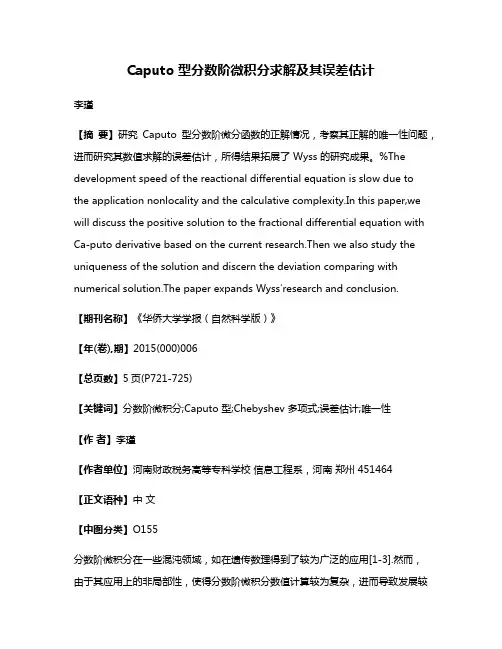
Caputo 型分数阶微积分求解及其误差估计李瑾【摘要】研究Caputo 型分数阶微分函数的正解情况,考察其正解的唯一性问题,进而研究其数值求解的误差估计,所得结果拓展了 Wyss 的研究成果。
%The development speed of the reactional differential equation is slow due to the application nonlocality and the calculative complexity.In this paper,we will discuss the positive solution to the fractional differential equation with Ca-puto derivative based on the current research.Then we also study the uniqueness of the solution and discern the deviation comparing with numerical solution.The paper expands Wyss′research and conclusion.【期刊名称】《华侨大学学报(自然科学版)》【年(卷),期】2015(000)006【总页数】5页(P721-725)【关键词】分数阶微积分;Caputo 型;Chebyshev 多项式;误差估计;唯一性【作者】李瑾【作者单位】河南财政税务高等专科学校信息工程系,河南郑州 451464【正文语种】中文【中图分类】O155分数阶微积分在一些混沌领域,如在遗传数理得到了较为广泛的应用[1-3].然而,由于其应用上的非局部性,使得分数阶微积分数值计算较为复杂,进而导致发展较为缓慢[4].Diethelm[5]根据前人的研究成果[6-11],给出了几种较为常见的分数阶微积分的数值算法,并提出了分数阶微积分的Gauss求解原理及算法.本文基于Sugiura等[12]的分数阶微积分Chebyshev 多项式数值算法模型,考察Wyss等[13]设计的Caputo 型分数阶微分函数的正解情况,进而研究其数值求解的误差估计.Wyss和Chneider建构了分数阶积分函数,令φ(x),ψ(x)为已知函数,所组成的偏微分方程为为进一步研究高阶分数阶积分,Miyakoda拓展了Wyss的研究成果,建构基于Chebyshev多项式逼近的高阶分数阶积分[13].为此,令函数f(x)分数阶积分为结合文献[3]的研究,对上述方程进行多项式逼近,可得到式(4)中:;δk=0.5.令插值节点于是,可得到Chebyshev多项式为T0(x)=1,T1(x)=x,Tn+1(x)=2xTn(x)-Tn-1(x).结合式(4),由方程(1)可得为了进一步得出该多项式的算法,记pn为式(4)的 n 次多项式,于是有令(2x-1),0≤t≤1,由式(6),有于是,可得到由方程(9)中Ti(2x-1)(i=1,2,…,n)的系数,可以得到所以,分数阶积分(1)的数值算法为式(11)中: α>a,t∈[0,1],ak,bk由方程(4)及方程(10)给出.首先,给出Caputo型分数阶导数的定义.令函数f(t)的Caputo型分数阶导数为式(12)中:Γ(·)是Gamma函数.接下来,对该导数进行Chebyshev多项处理,可得令为上式的n-2次多项式,则存有Ln-2多项式满足假设(2x-1),0≤x≤1,在[x,t]区间内,对上式积分,得到进而得到再令(2x-1).根据文献[3]的研究,ak,ck,dk满足为了进一步明确bi,将方程(16)~(18)整合,可得到可以发现式(18)中:k=1,2,…,n-2;bn-1=bn-2=0.于是,可得到Caputo型的分数阶导数的数值算法为式(19)中:α∈(1,2),t∈[0,1],而dk,bk分别由方程(17),(18) 确定.上面给出了Caputo型分数阶微分的定义,并给出了其数值算法.接下来,利用混合单调算子不动点定理,考察Caputo型分数阶微分方程解的唯一性问题.当t∈(0,+∞),(0,∞)→R时,f(x)的a阶(a∈R+)分数阶积分为τ.所以,其Caputo型分数阶导数则为τ.假设G(t,s)>0(t,s∈(0,1)为Green函数,于是,在g∈[0,1],2≤a≤3,Caputo型分数阶导数微分方程为存在唯一解有上式中:G(t,s)满足∀t,s∈(0,1).此时的积分空间C为Banach空间,即∀x,y∈C[0,1],x≤y≤⇔∀t∈[0,1],x(t)≤y(t)集合空间成立.设P={x∈C[0,1]|x(t)≥0,t∈[0,1]},所以P为Banach空间C的正规锥,于是提出如下假设.假设1 f(t,u,v)∶[0,1]×[0,∞)×[0,∞)→[0,∞)连续,且f(t,0,1)≠0.假设2 当t∈[0,1],v∈[0,∞)时,在u∈[0,+∞)区间,f(t,u,v)单调递增;当t∈[0,1],u∈[0,+∞)时,在v∈[0,+∞)区间,f(t,u,v)单调递减;∀γ∈(0,1),存在φ(γ)∈(γ,1),使f(t,γu,γ-1)≥φ(γ)f(t,u,v),∀u,v∈[0,∞).于是,提出以下3点结论.1) 存在r∈(0,1)及u0,v0∈Pw,使不等式rv0≤u0<v0成立,并满足s.上式中: w(t)=t,t∈[0,1].2) 在P={x∈C[0,1]|f(x)≥0,x∈[0,1]},Caputo分数阶微分方程具有唯一解u*.3) ∀x0,y0∈P,构造迭代序列上式中: n=1,2,….当n→∞时,xn(t)→u*(t),yn(t)→u*(t)成立.根据文献[15]的研究,令积分空间为<∞,0≤θ≤2π,假设f(x)解析于Cr,且x∈[0,1],则有由于前述的Chebyshev多项式pn(x)具有解的有界性和一致性,所以有于是,在积分空间Cr上,Chebyshev多项式分数阶积分f(x)的数值算法具有误差估计为式(22)中:|f(z)|,r>1.因为z=(w+w-1+2)/4及于是有所以,在积分空间Cr上,Chebyshev多项式分数阶积分f(x)的数值算法具有的误差估计满足于是,En(t)=f(t)-pn(t)=An+1(t)Bn(t),又由于Chebyshev多项式f(x)的一致有界性,所以有上式中:|Bn(t)|;||;|B″n(t)|;1<a<2.注上述结论中o的含义为n→+∞时,Chebyshev多项式f(x)数值算法误差的收敛速率.【相关文献】[1] PODLUBNY I.Fractional differential equations, mathematics in science and engineering[M].New York:Academic Press,1996:120-125.[2] MILLER K S,Ross B.An introduction to the fractional calculus and fractional differential equations [M].New York:John Wiley,1998:76-91.[3] HIEBER place transforms and α-time integrated semigroups[J].ForumMath,1991,120(3):595-612.[4] 徐明瑜,谭文长.中间过程、临界现象:分数阶算子理论、方法、进展及其在现代力学中的应用[J].中国科学(G辑),2006,36(3):198-229.[5] DIETHELM K.An improvement of a nonclassical numerical method for the computation of fractional derivatives[J].Numer Algor,2009,131(1):209-254.[6] SUGIURA H,HASEGAWA T.Quadrature rule for Abel′s equations: Uniformly approximating fractional derivatives[J].Comput Appl Math,2009,223(1):460-471. [7] FOX C.The G and H functions as summertrical Fourier kernels[J].Trans Amer Math Soc,1961(98):396-410.[8] ELLIOTT D.ELLIOTT Truncation errors in two Chebyshev series approximations [J].Math Compute,1965(19):234-248.[9] FUJITA Y. Fujita Cauchy problems of fractional order and stable processes[J]. Japan J Appl Math, 1990, 7(3): 459-476.[10] FUJITA Y.Integro differential equation which interpolates the wave equation[J].Osaka J Math,1990,116(27):797-804.[11] YCAN L,AGTTAWAL O P.A numerical scheme for dynamic systems containing fractional derivatives[J].ASME J Vibr Acoust,2002,124(2):321-324.[12] HASEGAVA T,SUGIURA H.Uniform approximation to fractional derivatives of functions of algebraic; singularity[J].Compute Appl Math,2009,228(1):247-253.[13] SCHNEIDER W R,WYSS W.Fractional diffusion and wave equations[J].J Math Phys,1989,134(30):129-139.[14] FUJITA Y.Energy inequalities for interop-partial differential equations with Riemann Lowville integrals[J].SIAM J Math Anal,1992(23):1179-1201.[15] BAI Zhanbing.Eigenvalue intervals for a class of fractional boundary valueproblem[J].Computers and Mathematics with Applications,2012,64(10):3248-3261.。
空间分数阶laplace算子空间分数阶Laplace算子是一种新颖的算子,它是将传统的拉普拉斯算子进行推广而得到的。
与传统的拉普拉斯算子不同,空间分数阶Laplace算子考虑了非局部和非线性的特性,在许多领域都具有广泛的应用前景。
空间分数阶Laplace算子的数学表达式为:$(-\Delta)^s u(x) = \frac{1}{C_{n,s}}P.V. \int_{R^n} \frac{u(x)-u(y)}{|x-y|^{n+2s}}dy$其中,$s$为分数阶,$n$为空间维数,$C_{n,s}$为归一化常数,$P.V.$表示斯特尔切斯积分中的主值。
空间分数阶Laplace算子的主要特点是具有非局部性和非线性性。
具体来说,它包含了整个定义域内所有点的信息,而不仅仅是局部邻域的信息。
它还可以处理非线性问题,将高阶导数整合到一个算子中,因此可以处理更广泛的问题。
在应用方面,空间分数阶Laplace算子已经被广泛运用于图像处理、信号处理、生物医学工程、物流运输管理等领域。
例如,在图像处理中,基于空间分数阶Laplace算子的图像去噪算法可以去除噪声和保留细节信息;在信号处理中,空间分数阶Laplace算子可以被用作一种滤波器,使信号中的噪声被减少或者去除;在生物医学工程中,该算子可以被用来刻画肿瘤组织的形态特征,从而辅助医学诊断;在物流运输管理中,该算子可以对物品的运动轨迹进行建模,预测其到达时间,更为精确地规划路径等等。
总之,空间分数阶Laplace算子是一种具有广泛应用前景的数学算子,它具有非局部和非线性的特性,已经被广泛应用于图像处理、信号处理、生物医学工程、物流运输管理等领域,并展现出了良好的效果。
随着技术的不断进步和应用领域的不断扩展,空间分数阶Laplace算子还将有更加广泛的应用和发展。
分数阶偏微分方程的数值解—分析和算法分数阶偏微分方程是一类具有特殊微分阶数的偏微分方程,其在应用领域具有重要的意义。
本文将从分析和算法两个方面对分数阶偏微分方程的数值解进行探讨。
一、分析1. 分数阶微积分简介分数阶微积分是对传统微积分的一种扩展,它将微积分的概念从整数阶推广到分数阶。
分数阶导数和分数阶积分不仅适用于分数阶偏微分方程,也在信号处理、图像处理等领域有广泛应用。
2. 分数阶偏微分方程的特点与整数阶偏微分方程相比,分数阶偏微分方程具有更丰富的动力学行为和非局部性。
分数阶导数的存在使得系统的响应不仅与瞬时状态相关,还与历史状态相关。
这种非局部性导致了分数阶偏微分方程的分析更加困难。
3. 分数阶偏微分方程的数值解方法传统的整数阶偏微分方程的数值解方法不适用于分数阶偏微分方程。
常用的分数阶偏微分方程数值解方法包括有限差分法、有限元法、谱方法等。
这些方法将分数阶偏微分方程离散化为代数方程,然后使用计算机进行求解。
二、算法1. 有限差分法有限差分法是最常见的分数阶偏微分方程数值解方法之一。
基本思想是将偏微分方程中的导数用差分近似代替,将方程离散化为代数方程组。
常用的有限差分格式包括格点法、Jacob分数阶差分格式等。
2. 有限元法有限元法是另一种常用的分数阶偏微分方程数值解方法。
它将求解域划分为若干个子域,并在每个子域上建立近似方程。
通过求解这些子域上的代数方程组,得到原分数阶偏微分方程的数值解。
3. 谱方法谱方法是一种利用基函数进行逼近的分数阶偏微分方程数值解方法。
基函数的选取对于谱方法的精确度起到关键作用。
常用的基函数包括Chebyshev多项式、Legendre多项式等。
谱方法的优点是收敛速度快且精度高,但适用范围相对较窄。
三、应用1. 生物医学领域分数阶偏微分方程在生物医学领域有着广泛的应用,如癌症模拟、血管网络模拟等。
通过数值解方法,可以更好地理解和预测生物医学系统中的动力学行为。
2. 材料科学领域分数阶偏微分方程在材料科学领域的应用主要集中在材料的传输性质研究。
分数次奇异积分算子
分数次积分是一种介于整数次积分和微分之间的运算。
它在处理某些特殊函数和方程时具有独特的优势,能够更好地描述一些复杂现象。
分数次积分算子在信号处理、图像处理、物理学等领域都有着广泛的应用。
在信号处理中,分数次积分算子可以用来处理非平稳信号,提高信号处理的精度和效率。
在图像处理中,它可以用来进行图像增强、去噪和边缘检测等操作,使图像处理更加精确和准确。
在物理学中,分数次积分算子可以用来描述非线性系统、介质的复杂性以及非局部现象,为研究提供了新的思路和方法。
除此之外,分数次积分算子还在分数阶微分方程、分形几何、随机分析等领域有着重要的应用。
它不仅可以用来建立更加精确的数学模型,还可以帮助我们更好地理解自然界中的复杂现象。
总的来说,分数次积分算子作为一种新颖的数学工具,具有广泛的应用前景和深远的理论意义。
通过深入研究和应用,我们可以更好地认识和理解世界,推动科学技术的发展,为人类社会的进步做出贡献。
希望今后能够有更多的研究者和科学家投入到分数次积分算子的研究中,挖掘出更多的潜力和应用,为人类带来更多的创新和发展。
让我们共同努力,探索数学的奥秘,开拓科学的新领域,为人类的
未来铺平道路。
愿分数次积分算子的光芒照耀着我们前行的道路,指引我们不断前行。
http://www.paper.edu.cn Intermediate processes, critical phenomena: theory, method, progress of fractional operators and its applications to modern mechanics Xu Mingyu (徐明瑜)1 & Tan Wenchang (谭文长)2
1. Institute of Applied Mathematics, School of Math & System Science, Shandong University, Jinan 250100, China; 2. LTCS & Department of Mechanics and Engineering Science, Peking University, Beijing 100871, China
Correspondence should be addressed to Xu Mingyu (email: xumingyu@sdu.edu.cn) or Tan Wenchang (email: tanwch@mech.pku.edu.cn)
Abstract:From point of view of physics, especially of mechanics, we briefly introduce
fractional operators (with emphasis on fractional calculus and fractional differential equations) used for describing intermediate processes and critical phenomena in physics and mechanics, and their progress in theory and methods, and applications to modern mechanics. Some authors’ researches in this area in recent years are included. Finally, prospects and evaluation for this subject are made.
Keywords: fractional operators, intermediate processes, critical phenomena, modern mechanics
1 Brief introduction to the fractional operators (FO) When in the 17th century the integer calculus had been developed, Leibniz and L’Hospital probed into the problems on the fractional calculus (FC) and the simplest fractional differential equations (FOEs) through letters. Leibniz asked in a letter addressed to L’Hospital: Can the meaning of derivatives of integral order dnf(x)/dxn be extended to have meaning when n
is not an integer but any number (irrational, fractional or even complex-valued)? L’Hospital responded: What if n be 1/2? d1/2f(x)/dx1/2=? for f(x)=x. Leibniz, in a letter dated from Sept. 30, 1695, replied: It will lead to a paradox, from which one day useful consequences will be drawn. And, 124 years later (in 1819) Lacroix gave the correct answer of this problem for
the first time, i.e., π/2/
2/12/1
xdxxd=. After that in a long period of time, through great
efforts made by many mathematicians the Riemann-Liouville (R-L) fractional operators were finally formed. In Lebesgue integrable space L1(a, b) fractional integral operator with q order is
defined as:
{}∫−−−Γ= t 0 10)()()(1:)(τττdftqtfDqq
t,(1Re0≤
where denotes Gamma function. )(⋅ΓAs its inversion, the fractional differential operator with ν order is defined as:
- 1 -{}[{})(:)(00tfDdtdtfDntnnt−=νν],(0Re<−nν,Jn∈) (2)
At present, based on the different background and purpose there are some other definitions of FO, e.g. Caputo’s, Weyl’s and Erdely-Kober left and right fractional derivatives and so on[1~3]. During the initial stage of the foundation of FO, its theory and application were made very slow progress due to without supporting of physics and mechanics, especially due to a conflict with Newtonian integer order system of classical physics. And this situation had not changed until the end of 1970’s Prof. Mandelbrot [4](Yale University of American) proposed that there is a lot of fractional dimension in nature and technology in which the phenomenon of self-similarity between entirety and part exists and there is a close connection between fractional Brownian motion (fBm) and R-L FC. Since then as a foundation of fractional geometry and fractional dynamics, the theory of FO, in particular, the theory of FC and FDEs and researches of application have been developed rapidly in the world. In 1974, Oldham and Spanier [1] published the first celebrated monograph on
FC and the first international conference on FC was convened in USA. Proceedings of this conference in the form of a series of books entitled Lecture Notes in Mathematics was published for the first time in the same year[5]. The main property of FO is semigroup of operators. And it is easy to prove that it is a (C0)-semigroup of operators[6]. The property of FO which is different from one of integer operators is that it is a global (non-local) operator and a limit in the sense of ultra-long time[7] . Therefore it is contradictory with viewpoint of classical (Newtonian) mechanics. However, from point of view of coarse graining procedure in the sense of ultra-long time both of them can unify[7].
If we define the kernel function Kq(t)
as causal one , then (1) can
be equivalently rewritten as: ⎩⎨
⎧
≤>Γ
=−0 t 0 0 t)(/ )(1qttKq
q
{})(0tfDqt−= (where = is
generalized function and “*” denotes Laplace convolution). It is obvious that for an arbitrary non-trivial kernel function, FO has memory, i.e., it is non-Markovian process. And Markovian process recovers provided and only provided =)(*)(tftKq)(tKq)(/1qtqΓ−+qtD−0)(tKq)(0tKδ (K0=const, )(tδ is Dirac delta function). It is easy to calculate that fractional derivative of an arbitrary constant C0 is not equal to zero, and we have {})1(/000ααα−Γ=−tCCDt )10(≤